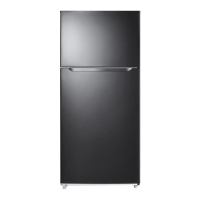14
Before You Call
TROUBLESHOOTING
GUIDE
Before calling for service, review this list. It may save you time and
expense. This list includes common occurrences that are not the
result of defective workmanship or materials in this appliance.
CONCERN POTENTIAL CAUSE COMMON SOLUTION
Appliance does not
run.
1. Unit is plugged into
a circuit that has a
ground fault interrupt.
2. T
emperature control is
in the OFF position.
3.
Unit ma
y not be
plugged in or plug may
be loose.
4. House fuse blown or
tripped circuit breaker.
5. Power outage.
1.
Use another cir
cuit. If you are unsure
about the outlet, have it checked by a
certified electrician.
2.
See Temperature Control Section.
3. Ensure plug is tightly pushed into
outlet.
4. Check house fuse or circuit breaker.
5. Check house lights. Call local Electric
Company.
Appliance runs too
much or too long.
1. Room or outside
weather is hot.
2.
Unit has r
ecently been
disconnected for a
period of time.
3.
Lar
ge amounts of
warm or hot food have
been stored recently.
4.
Door is opened t
oo
frequently or long.
5.
Door ma
y be slightly
open.
6. Temperature Control
is set too low.
7.
Door g
asket is dirty,
worn, cracked, or
poorly fitted.
1. It is normal for the appliance to work
harder under these conditions.
2.
It tak
es 4 hours for the unit interior to
cool down completely.
3. Warm food will cause unit to run
more until the desired temperature is
reached.
4.
W
arm air entering the interior causes
it to run more. Open door less often.
5.
See Door Will Not Close in this Bef
ore
You Call Section.
6.
Set contr
ol to a warmer setting. Allow
several hours for the temperature to
stabilize.
7.
Clean or change g
asket. Leaks in the
lid seal will cause unit to run longer in
order to maintain desired temperature.
Interior
temperature is
too cold.
Temperature Control is
set too cold.
Adjust the control to a warmer setting.
Allow several hours for the temperature
to stabilize.
Interior
temperature is
too warm.
1. Temperature Control
is set too warm.
2.
Door is k
ept open too
long or is opened too
frequently.
3.
Door ma
y not be
seating properly.
4.
Lar
ge amounts of
warm or hot food
may have been stored
recently.
5.
Appliance has r
ecently
been disconnected for
a period of time.
1.
Adjust control to a colder setting. Allow
several hours for the temperature to
stabilize.
2. Warm air enters the appliance every
time the door is opened. Open the lid
less often.
3. See Door Will Not Close in this Before
You Call section.
4. Wait until the appliance has had
a chance to reach its selected
temperature.
5.
F
reezer mode requires 4 hours to cool
down completely after appliance is first
plugged in.

